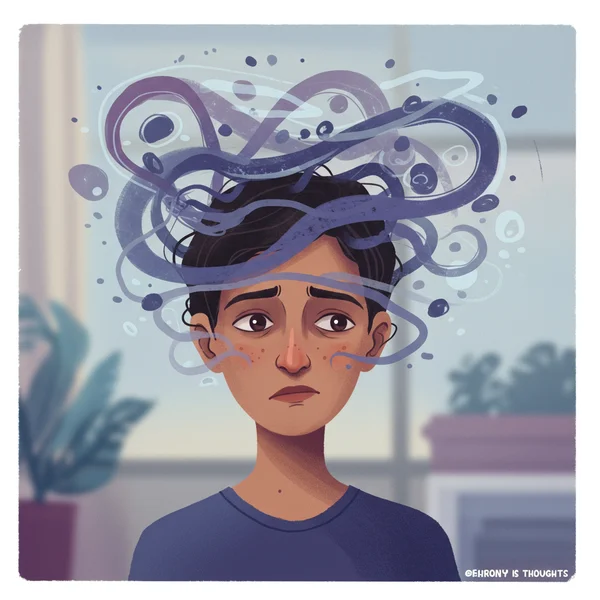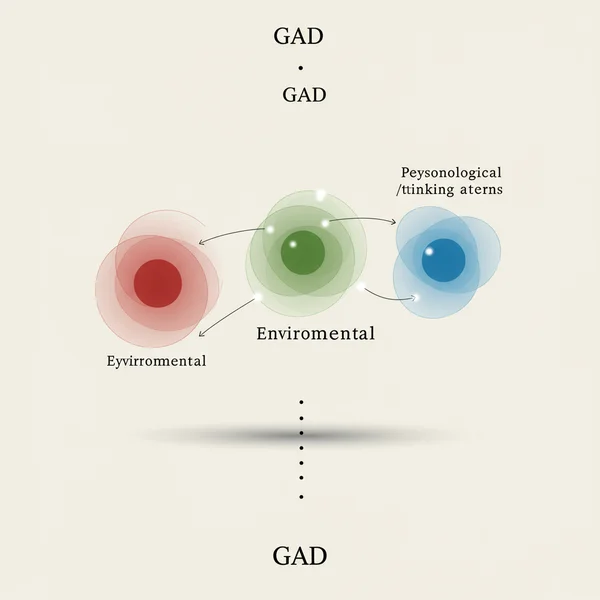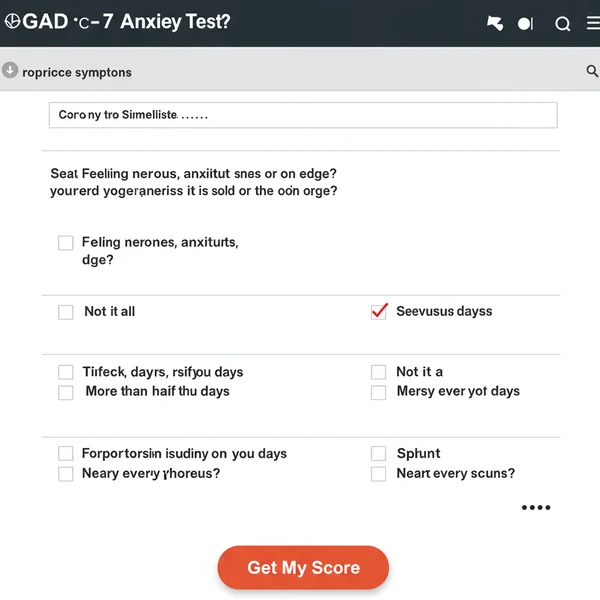Generalized Anxiety Disorder (GAD): Symptoms, Causes, & Your Anxiety Test
Do you find yourself constantly worrying about various aspects of life, from work deadlines to your health, even when there's no clear reason for it? This pervasive feeling of dread, which feels more intense and persistent than everyday stress, might be a sign of Generalized Anxiety Disorder (GAD). Many people wonder, Do I have anxiety or am I just stressed? This guide is here to help you understand GAD, recognize its symptoms, explore its causes, and discover actionable first steps, including how a free GAD-7 based anxiety test can offer you valuable, private insights.
Understanding your feelings is a powerful first step toward managing them. This guide aims to walk you through everything you need to know about GAD, providing you with knowledge and clarity on your path to well-being.
What is Generalized Anxiety Disorder (GAD)?
Generalized Anxiety Disorder (GAD) is more than just feeling worried from time to time. It's a mental health condition characterized by persistent and excessive worry about a variety of different things. People with GAD may anticipate disaster and can't seem to stop worrying about health, money, family, work, or other issues. This level of worry is often disproportionate to the actual circumstance and interferes significantly with daily life.
The key feature of GAD is the feeling of being out of control of your own worry. While others might feel anxious about a specific upcoming event, someone with GAD experiences a free-floating anxiety that latches onto one concern after another, making it difficult to relax and feel at ease.
Defining Chronic Worry and GAD
Chronic worry is the engine of Generalized Anxiety Disorder. It isn't just a fleeting thought; it's a persistent state of apprehension that can last for months or even years. For a diagnosis of GAD, this excessive worry and anxiety must occur on more days than not for at least six months. This isn't about having a bad week; it's a long-term pattern that colors your entire experience of the world.
This constant state of high alert is mentally and physically exhausting. It keeps your nervous system in overdrive, which is why GAD is often accompanied by a host of physical symptoms alongside the emotional turmoil.
The Difference Between Everyday Worry and GAD
Distinguishing between normal worry and GAD is crucial for self-awareness. While everyone worries, the intensity, duration, and impact of GAD are fundamentally different. Think of it this way: everyday worry is like a temporary rain shower, while GAD is like a constant, heavy fog that makes it hard to see ahead.
Here’s a simple breakdown:
-
Control: Everyday worry can typically be managed or set aside. With GAD, the worry feels uncontrollable and all-consuming.
-
Scope: Normal worry is often specific (e.g., "I'm worried about this presentation"). GAD-related worry is broad and shifts from one topic to another without resolution.
-
Impact: Everyday worry usually doesn't stop you from living your life. GAD significantly impairs your ability to function at work, in social settings, and at home.
-
Physical Symptoms: While stress can cause some physical discomfort, GAD is frequently linked to persistent physical symptoms like muscle aches and fatigue.

Recognizing GAD Symptoms: Emotional, Physical, & Cognitive Signs
GAD manifests in a variety of ways, affecting your thoughts, feelings, and body. Recognizing these signs is the first step toward understanding what you're experiencing. A comprehensive anxiety symptoms test can help you identify these patterns in yourself.
Emotional and Cognitive Symptoms of GAD
The mental and emotional toll is often the most noticeable aspect of GAD. These symptoms relate to your thoughts and feelings, creating a cycle of anxiety that can be hard to break.
- Persistent, excessive worrying about multiple areas of life.
- Difficulty concentrating or feeling like your mind "goes blank."
- Irritability and a feeling of being on edge.
- A sense of impending doom or danger.
- Indecisiveness and a fear of making the wrong decision.
- Inability to let go of a worry or set it aside.
These cognitive signs of anxiety can make it feel impossible to focus on the present moment, as your mind is always jumping to the next potential problem.
Physical Manifestations of Generalized Anxiety
Anxiety is not "all in your head." The mind and body are deeply connected, and chronic worry triggers a physical stress response that can lead to very real symptoms. Many people with GAD first seek medical help for these physical anxiety symptoms without realizing they stem from anxiety.
Common physical signs include:
- Fatigue and exhaustion, even after a full night's sleep.
- Muscle tension, aches, and soreness.
- Trouble falling or staying asleep (insomnia).
- Stomach problems, nausea, or irritable bowel syndrome (IBS).
- Trembling, twitching, or feeling shaky.
- Headaches and sweating.
How GAD Impacts Daily Life and Functioning
The combined effect of these emotional and physical symptoms can severely disrupt your daily life. Living with GAD can mean struggling to perform at work, avoiding social situations because they feel overwhelming, or finding that your relationships are strained due to your constant worry and irritability. Simple tasks can feel monumental, and the joy is often drained from activities you once loved.
If you recognize this pattern in your own life, it might be time to get some clarity. A confidential anxiety level test can be a helpful starting point.
Common Causes and Risk Factors for GAD
There is no single cause for Generalized Anxiety Disorder. Instead, it's believed to result from a complex interplay of biological, environmental, and psychological factors. Understanding these potential contributors can help demystify why you might be feeling this way.
Biological and Genetic Predispositions to GAD
Research suggests that genetics and anxiety are linked. If you have a family history of anxiety disorders, you may be more susceptible to developing one yourself. Furthermore, differences in brain chemistry and function can play a role. The way certain neurotransmitters, which are the brain's chemical messengers, operate can influence your mood and anxiety levels.
Environmental & Life Experiences Contributing to GAD
Your life experiences and environment are significant factors. Prolonged exposure to stressful situations, such as a high-pressure job, financial instability, or family conflict, can trigger or worsen GAD. Additionally, past trauma and anxiety are often connected, as traumatic events can change how your brain responds to perceived threats.
Personality Traits & Thinking Patterns in GAD
Certain personality traits, like being timid, perfectionistic, or having a tendency to avoid anything perceived as dangerous, can be linked to GAD. Similarly, cognitive patterns like overthinking anxiety or jumping to worst-case scenarios can create and sustain a cycle of worry. Understanding these internal habits is a key part of managing anxiety. Taking an online test can help you get confidential insights into these patterns.

Coping Strategies & First Steps for Managing GAD
While GAD can feel overwhelming, it is highly manageable. Taking the first steps to address your anxiety can empower you and put you back in control. The journey begins with self-awareness and implementing practical coping strategies.
Immediate Self-Help Techniques for GAD Symptoms
When you feel a wave of anxiety, having a few anxiety relief techniques on hand can make a world of difference. These methods help ground you in the present moment and calm your nervous system.
- Deep Breathing: Inhale slowly for four counts, hold for four, and exhale slowly for six. This activates the body's relaxation response.
- The 5-4-3-2-1 Grounding Method: Name five things you can see, four you can touch, three you can hear, two you can smell, and one you can taste.
- The 3-3-3 Rule: Look around and name three things you see. Then, name three sounds you hear. Finally, move three parts of your body.
Lifestyle Changes to Support GAD Management
Long-term management of GAD often involves making supportive lifestyle changes. Simple adjustments to your daily routine can build resilience against anxiety.
-
Consistent Exercise: Regular physical activity is a powerful way to reduce anxiety. Even a brisk 20-minute walk can boost your mood.
-
Balanced Diet: Limiting caffeine and processed foods while focusing on whole foods can help stabilize your mood and energy levels.
-
Prioritize Sleep: Aim for 7-9 hours of quality sleep per night. Create a relaxing bedtime routine to signal to your body that it's time to wind down.

The Role of Online Anxiety Tests (like GAD-7) in Self-Assessment
How do you know where to start? An online anxiety assessment can provide a clear, objective snapshot of what you're experiencing. The GAD-7 test is a scientifically validated screening tool used by healthcare professionals to measure the severity of anxiety symptoms. Our free and confidential anxiety test is based on this scale.
Taking the test gives you an immediate anxiety score, helping you quantify your feelings. You can also opt-in for a unique AI-powered report that provides personalized insights, potential challenges, and actionable steps. This is a private, pressure-free way to start your self-assessment and gain the clarity needed to move forward.
Taking the First Step: Understanding Your Anxiety
Living with Generalized Anxiety Disorder is challenging, but understanding your feelings and knowing there's a path forward can be incredibly empowering. By reading this, you've already taken an important step. Remember, self-awareness is key to managing anxiety effectively.
Are you ready to gain a clearer understanding of your own anxiety levels? Take the first step today with our free, confidential anxiety test. It takes less than three minutes and provides instant, valuable insights to help you on your journey.
Frequently Asked Questions About GAD & Anxiety Tests
How can I tell if my worry is GAD or just everyday stress?
The main difference lies in the three 'I's: Intensity, Intrusiveness, and Impairment. GAD involves worry that is far more intense, feels uncontrollable and intrusive, and significantly impairs your ability to function in daily life for six months or more. Everyday stress is typically tied to a specific cause and is more manageable.
What is the GAD-7 scale, and how does it work?
The GAD-7 is a 7-question screening tool widely used by doctors and therapists to assess the severity of generalized anxiety symptoms. This platform uses this clinically validated scale to provide you with a reliable and accurate anxiety score. Our tool is completely anonymous and serves as a first step to help you understand your feelings, with an optional AI analysis for deeper, personalized advice.
How accurate are online anxiety tests for GAD?
While an online test cannot provide a medical diagnosis, a high-quality test based on a validated scale like the GAD-7 is a highly accurate screening tool. It can effectively indicate the presence and severity of anxiety symptoms, making it a valuable resource for self-reflection and deciding whether to speak with a professional. See for yourself with our confidential test.
What should I do if my GAD test score is high?
A high score is not a reason to panic, but rather a sign to take your feelings seriously. Use it as a conversation starter with a trusted doctor or mental health professional. They can provide a formal diagnosis and discuss treatment options, such as therapy (like CBT) or medication. Your score is a piece of information that empowers you to advocate for your mental health.

Disclaimer: This article is for informational purposes only and does not constitute medical advice. Our test is a screening tool, not a diagnostic instrument. Please consult a qualified healthcare professional for any health concerns.